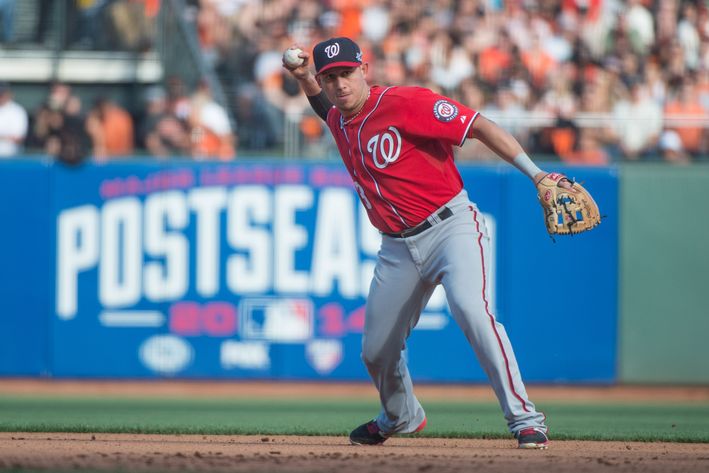
I wrote about the acquisition of Asdrubal Cabrera the other day, and how the deal might be better than the initial gut reaction might assume — that is, supposing the Rays can cobble together a trade of Yunel Escobar. I included an offensive analysis of Cabrera in that article, while also incorporating a piece from Dock of the Rays blog which went into great detail on that very subject. Danny Russell (DRaysBay) took a look Cabrera the defender Thursday, and I thought I’d re-post that article below. After all, a complete view of the newest Ray must include all facets of Cabrera’s game. And without further adieux,
Evaluating Asdrubal Cabrera, the Defender
by: Danny Russell (DRaysBay)
Asdrubal Cabrera doesn’t have world beating defense, but that’s not an indictment. Most of the negative reports out there come from his days at short stop, which may not be his position in the future.
Cabrera was acquired last season by the Nationals at the trade deadline to play second base in their playoff push. The acquisition was an immediate upgrade for Washington, but the results for the Nationals were not what shows up in the spreadsheet.
The story on the field differed from the numbers you might find on Fangraphs, but there’s room to wonder how much of that discrepancy was merely transitional struggles.
Cabrera was credited with -10 defensive runs saved at the second base last season, comparable to Ben Zobrist’s +1, but given Cabrera’s more positive performance at short stop earlier in the season (-7 DRS over twice the innings played), there’s a reasonable expectation that a full season at second base would score higher.
If you extrapolate -10 DRS over a full season the picture is ugly, but that’s not great science. Second base is a markedly easier position to field than short stop, but when Cabrera was sent to Washington to fill their void at second, he had not played the position since 2009. It’s probable that he scored low at the position due to awkwardness more than talent.
So let’s rewind to Cabrera’s comfort zone. Consider how the three starting middle infielders on the Rays roster performed against each other at short stop in 2014, in out-of-zone scores for range and defensive runs saved.
| Player | Position | Innings | DRS | OOZ | OOZ/150 |
| Asdrubal Cabrera | SS | 824 | -7 | 52 | 85 |
| Ben Zobrist | SS | 236 | 0 | 14 | 80 |
| Yunel Escobar | SS | 1183 | -24 | 66 | 75 |
That’s a small sample size for Zobrist, but when league average OOZ/150 is a score of 77 at short stop, this glimpse is respectable for all three.
Adding some context: Zobrist is aging and has spent most of his career on turf, and Escobar is coming off a season seemingly full of mental blunders. If the Rays had to choose a short stop, 29-year old Asdrubal Cabrera looks more reliable, based on 2014 data.
Now let’s take a look at the depth at second base, including Nick Franklin and Logan Forsythe, who are an option to platoon at second base next season. Franklin really only had numbers from 2013, so I used his last two seasons if data, but rest are 2014 numbers:
| Player | Position | Innings | DRS | OOZ | OOZ/150 |
| Asdrubal Cabrera | 2B | 432 | -10 | 13 | 41 |
| Ben Zobrist | 2B | 625 | 1 | 27 | 58 |
| Nick Franklin (13-14) | 2B | 924 | 0 | 70 | 102 |
| Logan Forsythe | 2B | 553 | 2 | 35 | 85 |
What should jump out immediately, if the eye test hadn’t already told you, is that the two guys on the bench have some serious range. League average here is a 55 OOZ/150, and for those curious, the league DRS count was 3 runs saved at second base last season, and -5 at short stop. DRS isn’t kind to Cabrera during his time at second base, but he scored near average at short, the more difficult position.
Cabrera’s arm grades well for the middle infield, that’s not a concern, and his defensive range should play well toward the right side, given what we observe at short stop. My immediate reaction to the Cabrera signing was to wax-poetic about the step down in defense, at either middle-infield position, but after a longer look at the numbers above — and then some tape — I’m not so sure. Particularly if the Rays follow the Nationals in deploying him at second base. Just take a look at this:
On paper, Cabrera’s numbers weren’t shiny in 2014, but his performance was not below standards to be a starting positional player in the middle-infield. He was top-rated among free agents at 2B/SS for good reason. Then take into account how nice his play looks on the field, and suddenly this move is a lot better than we gave credit just days ago.
The signing of Cabrera was clearly a preemptive move by the Rays to allow a trade of one of their middle infielders. Having taken a look at his play on either side of the bag over the past few days, I’d be comfortable with him taking over either side.
DC’s announcers in the video above were quite pleased with Cabrera’s performance, and they were watching him turn and burn day in and out for a few months. With defensive gems like that, it might be easy for Rays fans to get excited too.
A full off-season of preparation for second base may yield quality results for the Rays next season, or at least league average play at short. Even if it doesn’t show in the spreadsheet, there should be a lot to like.
